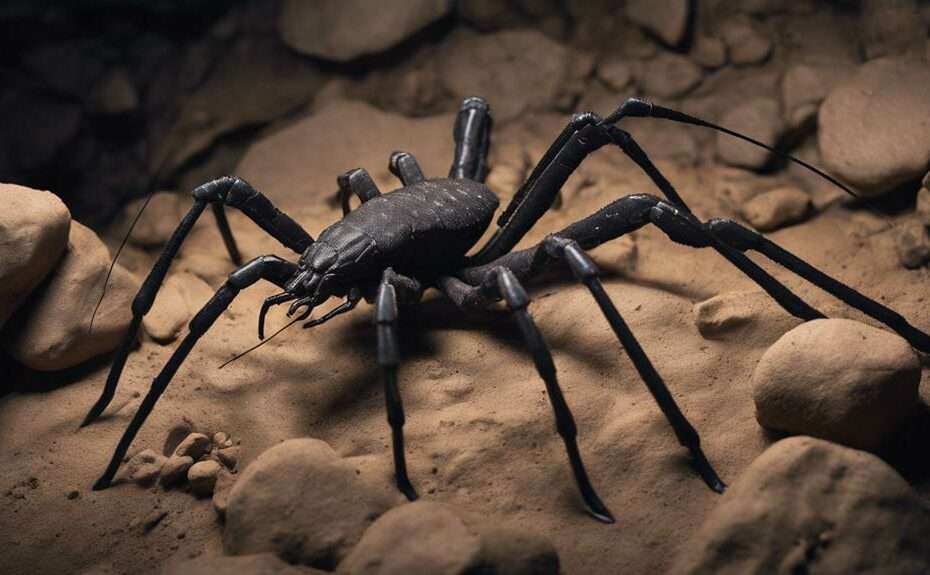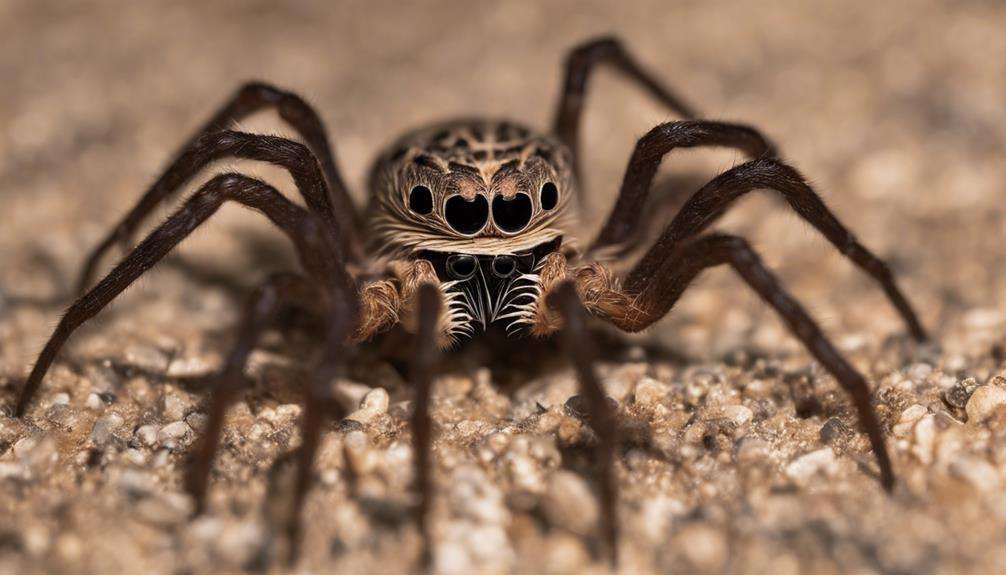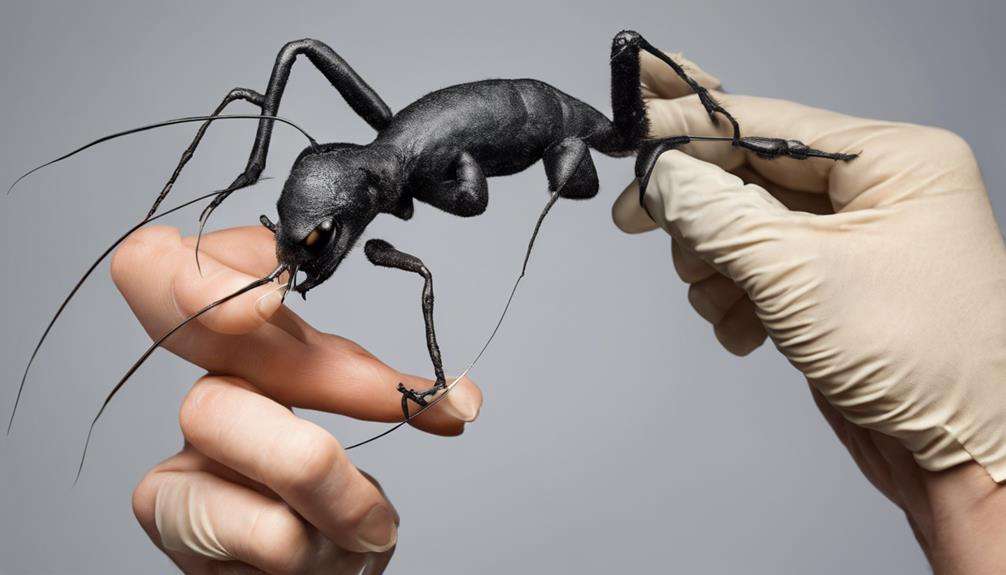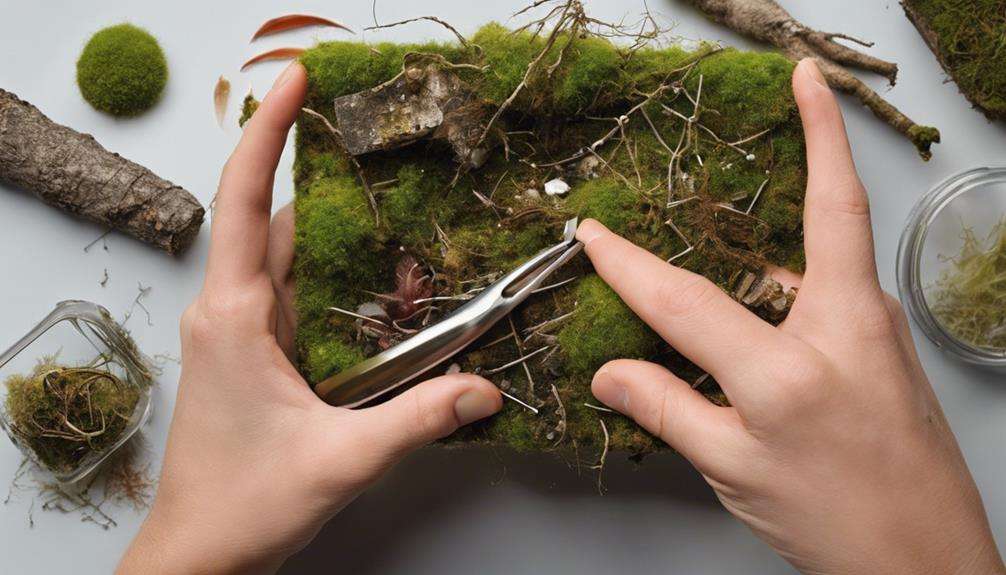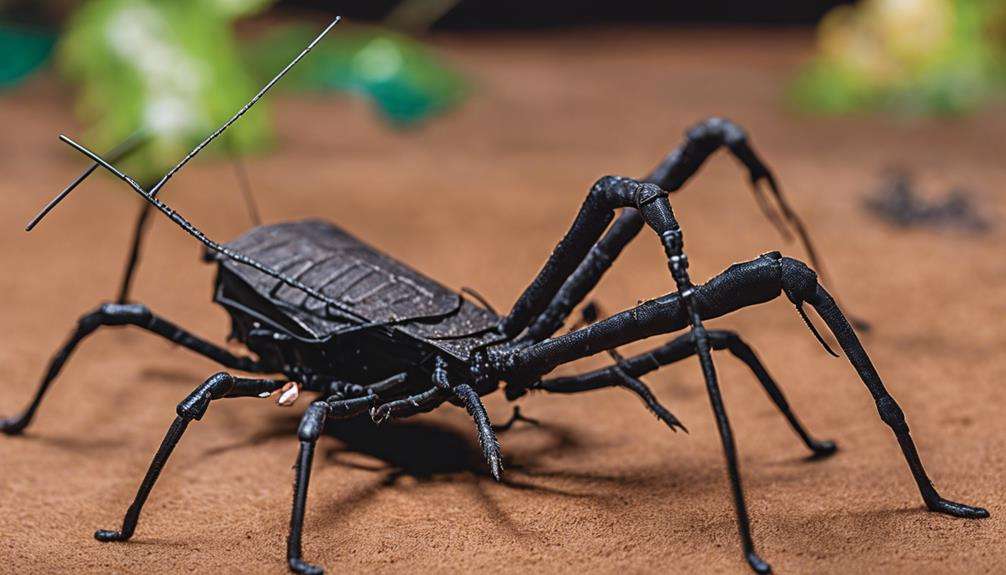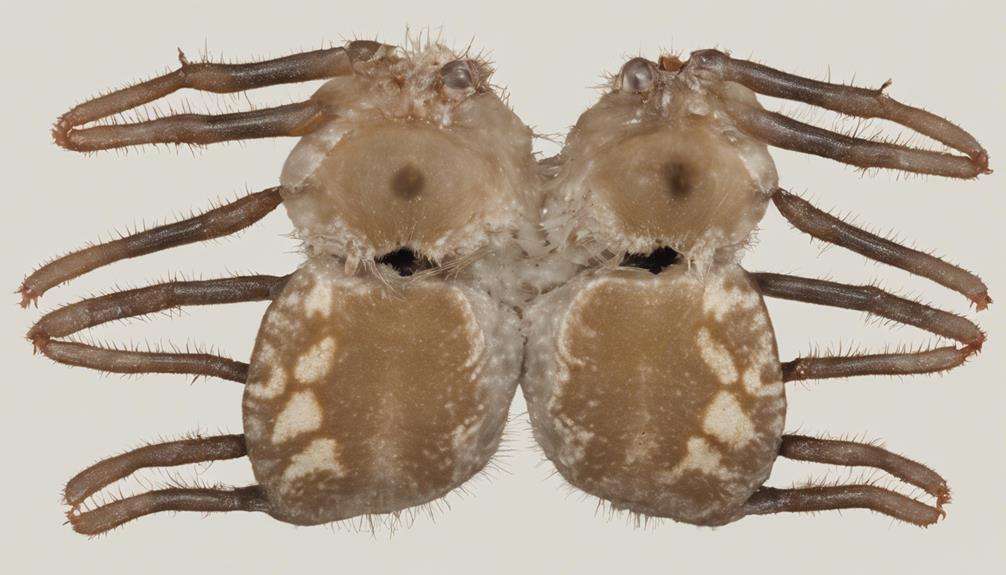In a curious twist of fate, tailless whip scorpions have a penchant for habitats that mirror their natural arboreal dwellings.
The key lies in crafting an environment that balances humidity, climbing opportunities, and security for these intriguing creatures.
But what makes these habitats truly unique, and how can you ensure your tailless whip scorpion thrives?
Stay tuned to uncover the secrets behind creating the perfect haven for these enigmatic arachnids.
Key Takeaways
- Tailless whip scorpions thrive in terrariums at least twice their diameter for ample movement.
- Maintain temperatures between 75-85°F with a gradient for basking and cooling.
- Keep humidity levels at 70-80% by misting and using a gauge for monitoring.
- Provide consistent lighting with a 12-hour cycle, using 6500K fluorescent or LED lights for well-being.
Minimum Terrarium Size for Tailless Whip Scorpions
To provide adequate living space for tailless whip scorpions, the terrarium size should be at least twice the diameter of the whip scorpion. This ensures that these arachnids have enough room to move around, explore, and exhibit their natural behaviors. Tailless whip scorpions, despite their name, possess eight long, thin legs that are sensitive and crucial for their mobility and survival. A spacious enclosure size not only accommodates their leg span but also allows for ease of movement, reducing stress and promoting overall well-being.
For instance, if you have a tailless whip scorpion with a leg span of 6 inches, the recommended terrarium size would be 12 inches in length, 12 inches in width, and 12 inches in height. This provides ample space for the whip scorpion to stretch its legs, climb, and burrow as these creatures are known to do in their natural habitats. Remember, adjusting the enclosure size is essential when housing multiple tailless whip scorpions to ensure each one has sufficient space to thrive.
UVB Requirements for Tailless Whip Scorpions
Tailless whip scorpions don't necessitate UVB lighting within their habitat, thriving instead on consistent lighting for a day-night cycle. They're primarily nocturnal creatures, seeking shelter during the day and becoming active at night.
While UVB lighting isn't a requirement, providing a 6500K fluorescent or LED plant light in their enclosure can be beneficial. This type of lighting not only helps illuminate the habitat but also supports live plant growth if present. It's essential to maintain a 12-hour light cycle daily to mimic their natural environment and ensure their well-being.
Tailless whip scorpions don't have specific UVB requirements like some reptiles or amphibians; however, proper lighting is crucial for their overall health and behavior. By focusing on consistent lighting and ensuring a suitable day-night cycle, you can create a comfortable habitat for these fascinating arachnids.
Optimal Temperature for Tailless Whip Scorpions
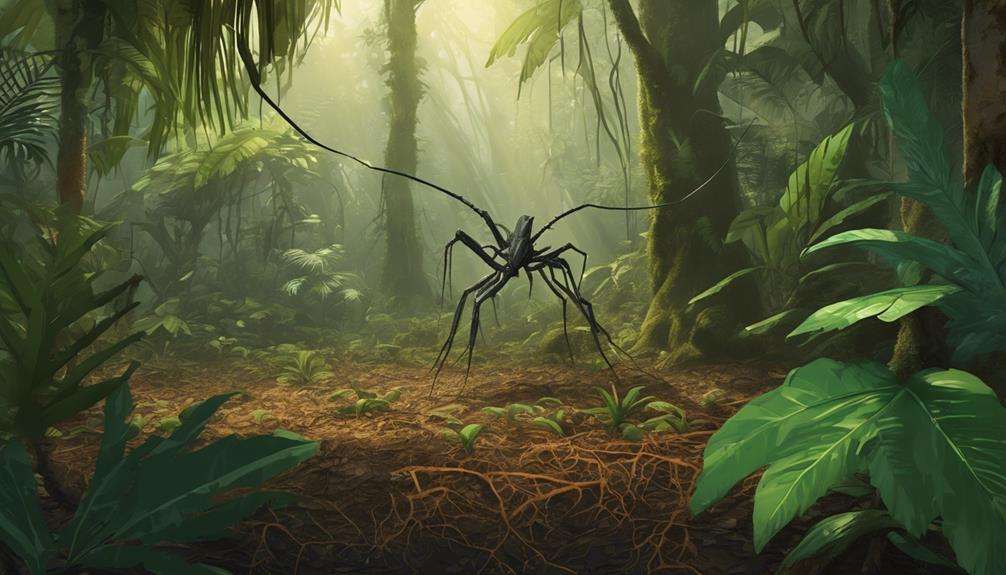
Tailless whip scorpions prefer temperatures ranging between 75-85°F for optimal health and activity.
Maintaining a consistent temperature gradient is essential to mimic their natural habitat conditions accurately.
Providing a warm basking spot along with cooler areas within the enclosure will help regulate their behavior and overall well-being.
Ideal Temperature Range
Within the optimal temperature range of 70-80°F, tailless whip scorpions exhibit peak health and activity levels, mirroring their tropical origins. To maintain this ideal temperature, provide a reliable heat source such as a low-wattage heat bulb within their enclosure.
Consistency in temperature is vital for the well-being of these creatures, as fluctuations outside this range can induce stress and affect their behavior and overall health. By creating a warm spot in their habitat, whip scorpions can regulate their body temperature effectively.
Monitoring and regulating the temperature diligently will ensure that tailless whip scorpions remain comfortable and active. Mimicking their natural tropical environment closely in terms of temperature is key to fostering a thriving habitat for these fascinating arachnids.
Environmental Temperature Considerations
Considering the optimal temperature range for tailless whip scorpions is crucial for maintaining their health and activity levels. These fascinating creatures, belonging to the order Amblypygi, thrive in temperatures ranging from 75-85°F.
To ensure their well-being, keep a warm environment with a basking spot reaching 85°F for thermoregulation and comfort. Avoid subjecting them to extreme temperature fluctuations as this can lead to stress and health issues.
Utilize a reliable heat source like a low-wattage heat bulb to establish a temperature gradient within the enclosure. Remember to consistently monitor temperatures with a digital thermometer to create a suitable habitat for tailless whip scorpions, especially considering their preference for high humidity environments.
Temperature Impact on Behavior
Maintaining a consistent temperature range between 75-85°F is vital for observing optimal behavior in tailless whip scorpions, influencing their activity levels and feeding patterns. At these temperatures, tailless whip scorpions are more active, displaying increased movement and responsiveness.
Their front legs, crucial for sensing the environment and capturing prey, show heightened agility and coordination within this optimal temperature range. Moreover, metabolism in tailless whip scorpions functions optimally at these temperatures, supporting efficient digestion and nutrient absorption.
Consistent exposure to temperatures outside this range can disrupt their feeding patterns and overall behavior, impacting their well-being. Therefore, regulating the temperature within the recommended 75-85°F range is essential to ensure the health and vitality of tailless whip scorpions.
Ideal Humidity Levels for Tailless Whip Scorpions

Wondering what humidity levels are ideal for tailless whip scorpions like Damon diadema? Here are some key points to consider:
- Tailless whip scorpions, such as Damon diadema, thrive in humidity levels around 70-80%.
- Maintaining proper substrate moisture by misting once a week is essential to sustain the required humidity.
- Observing the behavior of the whip scorpion can provide valuable insights into whether humidity levels need adjustment.
- Using a gauge to accurately monitor and regulate humidity levels is crucial for creating optimal conditions for your tailless whip scorpion.
Recommended Substrate for Tailless Whip Scorpions
To provide a suitable habitat for tailless whip scorpions like Damon diadema, selecting the appropriate substrate is crucial for maintaining optimal humidity levels in their enclosure. Whip scorpions thrive in environments with high humidity, making the choice of substrate essential. Using coco fiber substrate is recommended as it helps retain moisture, creating a suitable microclimate for these arachnids. Substrates like Zoo Med Eco Earth or Exo Terra Plantation Soil are also suitable options, aiding in mimicking the natural habitat of tailless whip scorpions.
It is advised to have at least 2 inches of lightly packed substrate in the enclosure to support burrowing behavior and regulate humidity effectively. Regularly replacing the substrate every other month is important to prevent mold growth and ensure a clean living environment for your whip scorpion. The substrate not only provides a medium for burrowing but also plays a crucial role in maintaining the necessary humidity levels for the well-being of your tailless whip scorpion.
Terrarium Decoration for Tailless Whip Scorpions
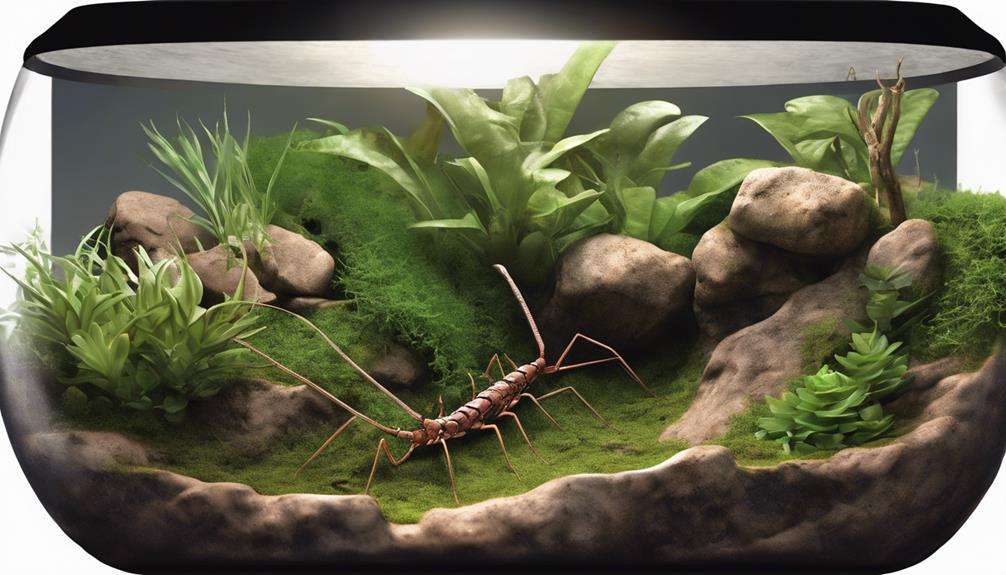
Consider incorporating cork bark or foam structures in the terrarium setup for tailless whip scorpions to provide climbing opportunities and mimic their natural arboreal habitat. When decorating the terrarium for these fascinating creatures, keep in mind the following tips:
- Cork Bark: Introduce cork bark pieces of various sizes to create a natural climbing environment for tailless whip scorpions. They'll enjoy exploring and perching on these structures, just like they'd in the wild.
- Foam Structures: Use foam structures strategically placed within the terrarium to offer additional climbing surfaces. These structures can also serve as hiding spots for your tailless whip scorpions, promoting their natural behaviors.
- Hanging Plants: Include hanging plants in the terrarium to provide cover and encourage exploration. Tailless whip scorpions appreciate having foliage to hide under and explore, adding complexity to their living space.
- Maintaining Humidity: Ensure the substrate remains slightly damp to help regulate humidity levels within the terrarium. This is crucial for the well-being of tailless whip scorpions, mimicking their natural habitat conditions.
Tailless Whip Scorpion Feeding Guide
Tailless whip scorpions require a diet consisting of 1-2 medium to large crickets every 7-10 days as adults to maintain their nutritional needs. It's essential to adjust the feeding frequency based on seasonal variations; offering more crickets in summer and fewer in winter ensures their well-being. Young tailless whip scorpions, on the other hand, need to be fed small crickets twice a week for proper nutrition. After a molt, it's advisable to wait 5-7 days before resuming feeding to guarantee they're ready to consume prey effectively.
When feeding tailless whip scorpions, it's crucial to monitor their eating habits closely. Remove any uneaten prey within 24 hours to maintain the cleanliness of their enclosure. This practice not only prevents uneaten crickets from causing stress to the whip scorpion but also helps in ensuring a hygienic environment for their overall health and well-being. By following these feeding guidelines, you can support the nutritional needs of your tailless whip scorpion effectively.
Handling Tips for Tailless Whip Scorpions
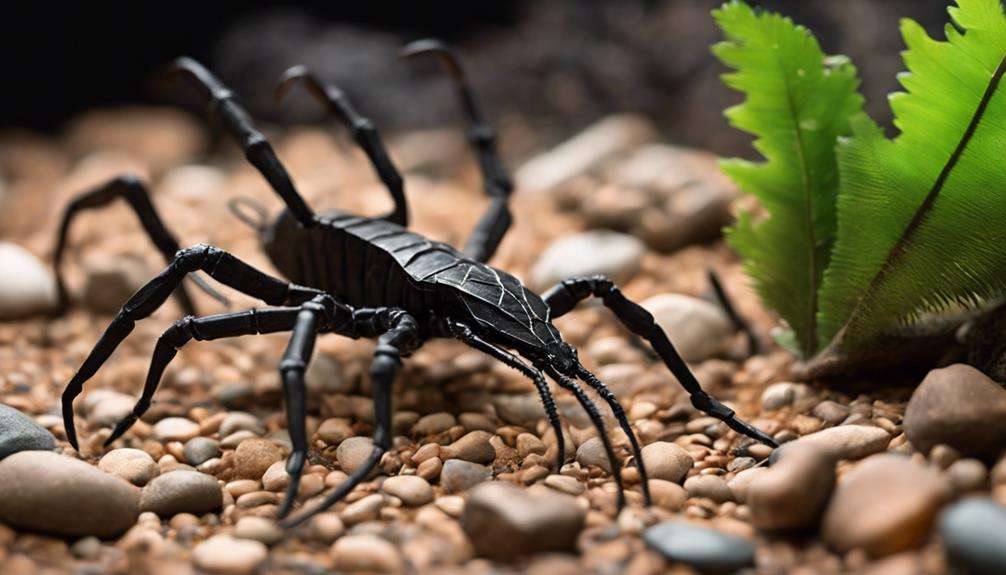
When interacting with tailless whip scorpions, handle them gently to prevent any harm to their delicate bodies and antennae-like legs. These creatures are sensitive to rough handling, so it's crucial to approach them with caution. Here are some tips to help you handle tailless whip scorpions effectively:
- Approach Slowly: Make slow and deliberate movements when interacting with tailless whip scorpions to avoid startling them.
- Support Their Body: When picking up a tailless whip scorpion, ensure you support their entire body to prevent any stress on their delicate legs.
- Avoid Pinching: Be mindful of their pinchers, especially if they feel threatened. Keep your fingers away from their front legs to prevent any accidental pinches.
- Observe Their Behavior: Pay attention to the tailless whip scorpion's body language. If they show signs of distress, gently place them back in their habitat to avoid causing them any unnecessary stress.
Tailless Whip Scorpion Care Comments
Tailless whip scorpions require a specialized habitat with climbing structures and hanging plants for cover and exploration.
Ensuring slightly damp substrate aids in successful molting, a crucial aspect of their care.
Housing Requirements
Arboreal enclosures are highly recommended for tailless whip scorpions due to their climbing nature, facilitating successful molting and providing exploration opportunities. When setting up a habitat for these creatures, consider the following:
- Cork bark or foam structures: These provide ample climbing surfaces and aid in molting processes.
- Maintaining substrate humidity: Keeping the substrate slightly damp helps regulate humidity levels, crucial for tailless whip scorpions' well-being.
- Hanging plants: These not only offer cover but also create exploration areas, mimicking the natural habitat of these arachnids.
- Simplicity of husbandry requirements: Tailless whip scorpions thrive in suitable arboreal setups, making them relatively easy to care for compared to other exotic pets.
Feeding and Handling
To ensure optimal care for tailless whip scorpions, feeding and handling practices must be carefully followed to maintain their health and well-being.
These arachnids use their specialized front legs to capture and handle prey. Adult tailless whip scorpions should be fed 1-2 medium to large crickets every 7-10 days, adjusting the frequency with the seasons. More food may be necessary in the summer months and less in winter. Remove any uneaten prey within 24 hours to keep the enclosure clean.
Young whip scorpions need small crickets twice a week to meet their nutritional requirements. After a molt, wait 5-7 days before feeding to ensure they're ready to consume prey. Proper feeding and handling are crucial for the overall health of tailless whip scorpions.
Tailless Whip Scorpion Habitat Characteristics

In suitable habitats for tailless whip scorpions, a variety of climbing structures such as cork bark or foam are essential for their thriving. When designing a habitat for Damon variegatus, consider the following characteristics:
- Arboreal Environment: Tailless whip scorpions are adapted to arboreal habitats, necessitating vertical space for climbing and exploration.
- Humidity Regulation: Maintaining slightly damp substrate aids in humidity regulation, crucial for successful molting processes.
- Cover and Exploration Opportunities: Hanging plants not only provide cover but also offer opportunities for tailless whip scorpions to exhibit their natural behaviors.
- Nocturnal Activity: These creatures prefer confined spaces and exhibit nocturnal behavior, being most active during the night.
Frequently Asked Questions
What Is the Best Enclosure for a Tailless Whip Scorpion?
For a tailless whip scorpion, create an enclosure setup with cork bark structures, slightly damp substrate, and hanging plants. This provides optimal conditions for climbing, molting, humidity regulation, cover, and exploration. Easy care in a suitable habitat.
What Is the Tailless Whip Scorpions Habitat?
In their natural environments, tailless whip scorpions thrive in humid tropical and subtropical regions. Their behavioral adaptations include being nocturnal and hiding during the day. Optimal conditions in captive care involve providing ample climbing surfaces and hanging plants for cover and exploration.
What Is the Habitat of the Whip Spider?
In tropical rainforests, whip spiders thrive, seeking refuge in caves during the day. Their nocturnal nature guides them through the dimly lit environs, displaying adept climbing skills. You'll find them perched high, ready for their nightly hunt.
Where Can You Find Tailless Whip Scorpion?
In tropical rainforests, you'll find tailless whip scorpions under bark and stones, preferring dark, confined spaces. They may also inhabit caves or seek shelter in homes, emerging at night to hunt. In deserts, they burrow underground.
Conclusion
In conclusion, tailless whip scorpions thrive in arboreal habitats that mimic their natural environment. They require climbing surfaces, hanging plants, and humid conditions to molt successfully.
Providing a slightly damp substrate and a secure, confined space is crucial for their well-being. Tailless whip scorpions are best suited to arboreal setups that prioritize humidity and climbing opportunities, ensuring their overall health and longevity in captivity.
